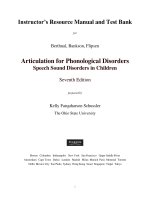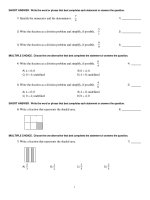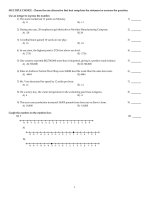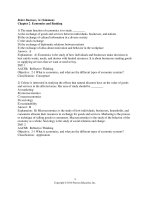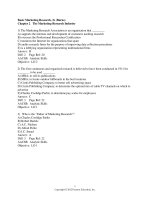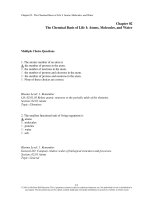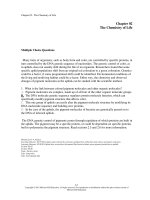Health promotion in nursing 3rd edition maville test bank
Bạn đang xem bản rút gọn của tài liệu. Xem và tải ngay bản đầy đủ của tài liệu tại đây (128.81 KB, 4 trang )
Chapter 2 Nursing Concepts and Health Promotion
MULTIPLE CHOICE
1. The American Nurses Association’s Nursing Scope and Standards of Practice:
a. addresses the profession’s concern with the quality and accountability of nursing.
b. describes both professional and vocational nursing standards of care.
c. describes the profession’s non-negotiable ethical standards.
d. focuses on standards of care strictly applicable to clinical practice.
ANS: A
PTS: 1
DIF: Challenging
2. Nursing’s metaparadigm refers to:
a. a global definition of health care.
b. nursing theory.
c. standards that are applicable to the profession.
d. common concepts that describe nursing and are specific to the discipline.
ANS: D
PTS: 1
DIF: Challenging
3. According to Maslow’s Hierarchy of Needs, before an individual can address safety and security
needs, he or she must first satisfy their:
a. love and belonging needs.
b. physiological needs.
c. self-actualization needs.
d. self-esteem needs.
ANS: B
PTS: 1
DIF: Easy
4. Which of the following is a subcategory of Self-Esteem Needs according to Maslow?
a. Approval
b. Intimacy
c. Rules
d. Structure
ANS: A
PTS: 1
DIF: Easy
5. Nursing is considered a profession because it fits well with which of the following criteria commonly
found in a profession?
a. Belongs to the medical discipline
b. Has established professional standards
c. Is accredited by the National League for Nursing
d. Is taught in community colleges and vocational schools
ANS: B
PTS: 1
DIF: Challenging
6. Which of the following would be most likely to engage in health-promotion nursing research?
a. Associate degree prepared nurse
b. Baccalaureate of Science in Nursing prepared nurse
c. Diploma prepared nurse
d. Doctorate in Nursing prepared nurse
ANS: D
PTS: 1
DIF: Easy
7. A career ladder approach in nursing refers to:
a. associate or diploma educational pathways.
b. employment according to the educational level of the nurse.
c. nursing education at the university level.
d. transitioning of nursing from one educational level to the next.
ANS: D
PTS: 1
DIF: Challenging
8. The difference in health-promotion competencies between a nurse educated at the associate degree
level and a baccalaureate prepared nurse (BSN) is that the BSN prepared nurse:
a. develops teaching plans concerning health promotion, maintenance, and restoration of
health.
b. implements nursing care to promote health and manage acute and chronic health problems.
c. manages nursing care for a limited number of patients.
d. performs comprehensive assessments of patients relative to those factors impacting each
patient’s health status.
ANS: D
PTS: 1
DIF: Difficult
9. Systems Theory proposes that change is:
a. health care directed.
b. impacted by a person’s environment.
c. never haphazard.
d. dependent on the extent of individual behaviors.
ANS: B
PTS: 1
DIF: Difficult
10. Which of the following theories would be most appropriate for the nurse to use when educating a
38-year-old diabetic Asian patient about her diet?
a. Adaptation Theory
b. Change Theory
c. Transcultural Theory
d. Values Theory
ANS: C
PTS: 1
DIF: Difficult
11. Which of the following theories is most closely related to Needs Theory?
a. Adaptation Theory
b. Motivation Theory
c. Systems Theory
d. Transcultural Theory
ANS: B
PTS: 1
DIF: Challenging
12. Which of the following nursing metaparadigm concepts is most closely associated with Florence
Nightingale’s Theory of Nursing?
a. Environment
b. Health
c. Nursing
d. Person
ANS: A
PTS: 1
DIF: Easy
13. Which of the following theorists is most closely associated with Systems Theory?
a. Imogene King
b. Jean Watson
c. Martha Rogers
d. Virginia Henderson
ANS: C
PTS: 1
DIF: Challenging
14. Health promotion is an essential concept useful to nursing in:
a. defining nursing practice.
b. identifying nursing’s need for change.
c. identifying professional assumptions.
d. providing theoretical frameworks.
ANS: A
PTS: 1
DIF: Challenging
15. Nursing theorists organize nursing theory by:
a. accessing nursing definitions.
b. addressing nursing’s metaparadigm concepts.
c. describing nursing’s philosophy of health care.
d. providing standards of nursing practice.
ANS: B
PTS: 1
DIF: Challenging
TRUE/FALSE
1. The concept of health promotion is a new one to the nursing profession.
ANS: F
PTS: 1
DIF: Easy
2. Nursing’s metaparadigm helps to critically unify and evaluate concepts that are characteristic of
nursing.
ANS: T
PTS: 1
DIF: Easy
3. The four concepts that are addressed in nursing’s metaparadigm are person, disease prevention,
environment, and nursing.
ANS: F
PTS: 1
DIF: Easy
4. There is no current consensus on what constitutes health.
ANS: T
PTS: 1
DIF: Easy
5. Health can be described in terms of the role of a person in society.
ANS: T
PTS: 1
DIF: Easy
6. General Systems Theory was originally described in 2002.
ANS: F
PTS: 1
DIF: Challenging
7. Needs Theory may be used interchangeably with Adaptation Theory.
ANS: F
PTS: 1
DIF: Challenging
MATCHING
Match each nurse theorist to their Nursing Theory
a. Florence Nightingale
b. Dorothea Orem
c. Imogene King
d. Jean Watson
e. Madeleine Leininger
f. Martha Rogers
g. Rosemarie Parse
h. Sister Callista Roy
1.
2.
3.
4.
5.
6.
7.
8.
Adaptation Model
Cultural Care Diversity and Universality Theory
Environmental Theory of Nursing
Self-Care Theory
Science of Unitary Human Beings Theory
Theory of Goal Attainment
Theory of Human Becoming
Theory of Transpersonal Caring
1.
2.
3.
4.
5.
6.
7.
8.
ANS:
ANS:
ANS:
ANS:
ANS:
ANS:
ANS:
ANS:
H
E
A
B
F
C
G
D
PTS:
PTS:
PTS:
PTS:
PTS:
PTS:
PTS:
PTS:
1
1
1
1
1
1
1
1
DIF:
DIF:
DIF:
DIF:
DIF:
DIF:
DIF:
DIF:
Easy
Easy
Easy
Easy
Easy
Easy
Easy
Easy

